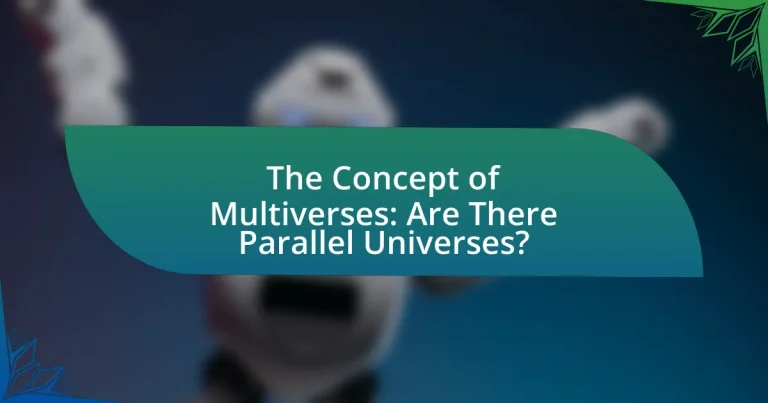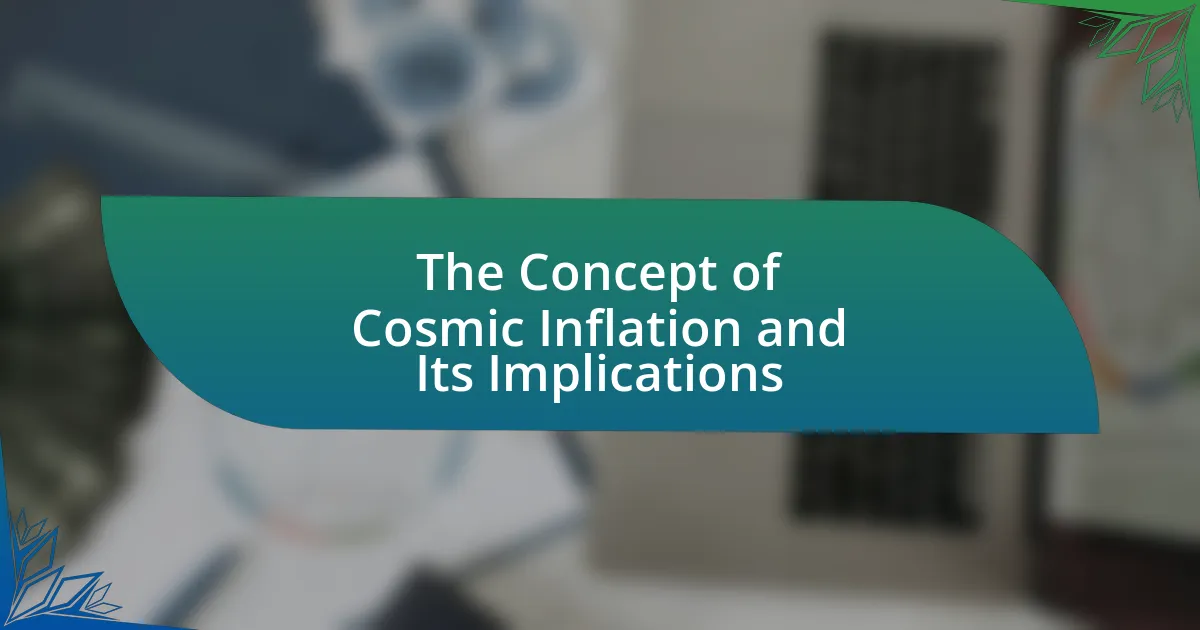The main entity of the article is the concept of multiverses, which posits the existence of multiple, potentially infinite universes that exist parallel to our own, each with distinct laws of physics and histories. The article explores various theories related to multiverses, including the Many-Worlds Interpretation of quantum mechanics, cosmic inflation, and the Bubble Universe Theory. It examines how these theories redefine our understanding of reality, free will, and identity, while also discussing the philosophical implications and ethical considerations that arise from the existence of parallel universes. Additionally, the article highlights the potential applications of multiverse theories in technology and scientific research, providing a comprehensive overview of this complex and evolving topic.
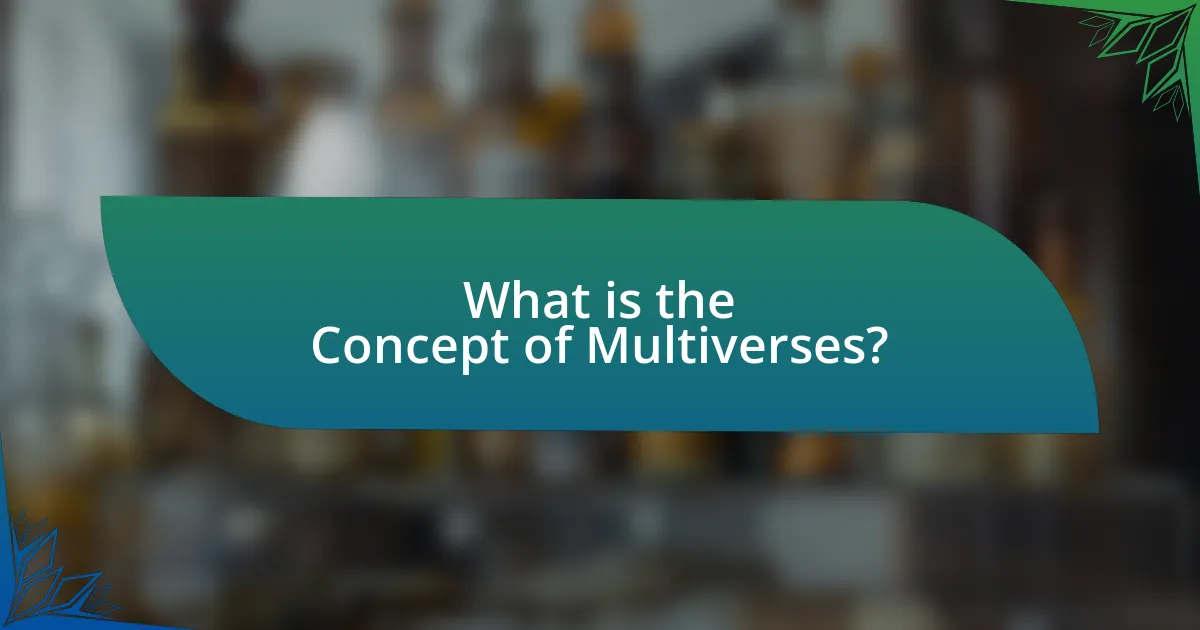
What is the Concept of Multiverses?
The concept of multiverses refers to the idea that multiple, possibly infinite, universes exist parallel to our own, each with its own distinct laws of physics, constants, and histories. This notion arises from various theories in physics, particularly in cosmology and quantum mechanics, suggesting that our universe is just one of many that could exist. For instance, the Many-Worlds Interpretation of quantum mechanics posits that every quantum event branches into different outcomes, creating a vast array of alternate realities. Additionally, the theory of cosmic inflation implies that different regions of space could stop inflating at different times, leading to the formation of separate universes with varying properties. These theories provide a framework for understanding the multiverse concept, supported by mathematical models and theoretical physics.
How do scientists define a multiverse?
Scientists define a multiverse as a hypothetical collection of multiple, possibly infinite, universes that exist parallel to each other, each with its own distinct laws of physics and properties. This concept arises from various theories in cosmology and quantum mechanics, such as the inflationary model, which suggests that different regions of space can undergo inflation independently, leading to the creation of separate universes. Additionally, the many-worlds interpretation of quantum mechanics posits that every quantum event branches into different outcomes, resulting in a vast array of alternate realities. These definitions are supported by theoretical frameworks and mathematical models, although empirical evidence for the existence of a multiverse remains elusive.
What are the different theories of multiverses?
The different theories of multiverses include the Many-Worlds Interpretation, the Bubble Universe Theory, the String Theory Landscape, and the Quantum Multiverse. The Many-Worlds Interpretation, proposed by Hugh Everett III in 1957, suggests that all possible outcomes of quantum measurements actually occur in separate, branching universes. The Bubble Universe Theory, stemming from cosmic inflation, posits that different regions of space can stop inflating at different times, leading to distinct universes with varying physical laws. The String Theory Landscape arises from string theory, indicating a vast number of possible vacuum states, each corresponding to a different universe with its own set of physical constants. Lastly, the Quantum Multiverse is a broader interpretation of quantum mechanics, suggesting that every quantum event spawns new universes for each possible outcome. These theories are supported by various interpretations of quantum mechanics and cosmological observations, providing a framework for understanding the potential existence of multiple universes.
How does the concept of multiverses relate to our understanding of the universe?
The concept of multiverses expands our understanding of the universe by proposing that multiple, potentially infinite, universes exist alongside our own, each with different physical laws and constants. This idea challenges the traditional view of a singular universe and suggests that our universe is just one of many possible realities. Theoretical frameworks such as string theory and quantum mechanics support the multiverse hypothesis, indicating that variations in initial conditions could lead to diverse outcomes in different universes. For instance, the Many-Worlds Interpretation of quantum mechanics posits that every quantum event branches into separate universes, reinforcing the multiverse concept. This perspective not only broadens the scope of cosmological inquiry but also raises questions about the nature of reality, existence, and the fundamental laws governing all possible universes.
Why is the idea of parallel universes significant?
The idea of parallel universes is significant because it challenges our understanding of reality and offers explanations for phenomena that are not easily explained by traditional physics. This concept, rooted in theories such as quantum mechanics and cosmology, suggests that multiple, perhaps infinite, universes exist alongside our own, each with different outcomes and possibilities. For instance, the Many-Worlds Interpretation of quantum mechanics posits that every quantum event branches into different outcomes, leading to the existence of parallel realities. This idea not only expands the scope of scientific inquiry but also influences philosophical discussions about existence, choice, and the nature of the universe, as evidenced by the work of physicists like Hugh Everett III, who first proposed this interpretation in 1957.
What implications do parallel universes have on our perception of reality?
Parallel universes challenge our perception of reality by suggesting that multiple, coexisting realities exist simultaneously, each with different outcomes and possibilities. This concept implies that our understanding of existence is limited to a single narrative, while in fact, countless variations of events and choices unfold in parallel dimensions. Theoretical frameworks, such as the Many-Worlds Interpretation of quantum mechanics, support this notion, indicating that every decision creates branching realities. This perspective can alter our understanding of free will, causality, and the nature of existence itself, as it posits that every possible outcome is realized in some universe.
How do parallel universes challenge traditional scientific views?
Parallel universes challenge traditional scientific views by introducing the idea that multiple, potentially infinite realities exist alongside our own, which contradicts the classical notion of a singular, observable universe. This concept, rooted in theories such as quantum mechanics and cosmology, suggests that events can branch into different outcomes, leading to distinct universes where different histories and realities unfold. For instance, the Many-Worlds Interpretation of quantum mechanics posits that every quantum event results in a branching of the universe, creating parallel realities. This fundamentally alters the understanding of causality and determinism, as it implies that all possible outcomes of a decision or event occur in separate, coexisting universes, thereby challenging the traditional scientific framework that relies on observable and testable phenomena.
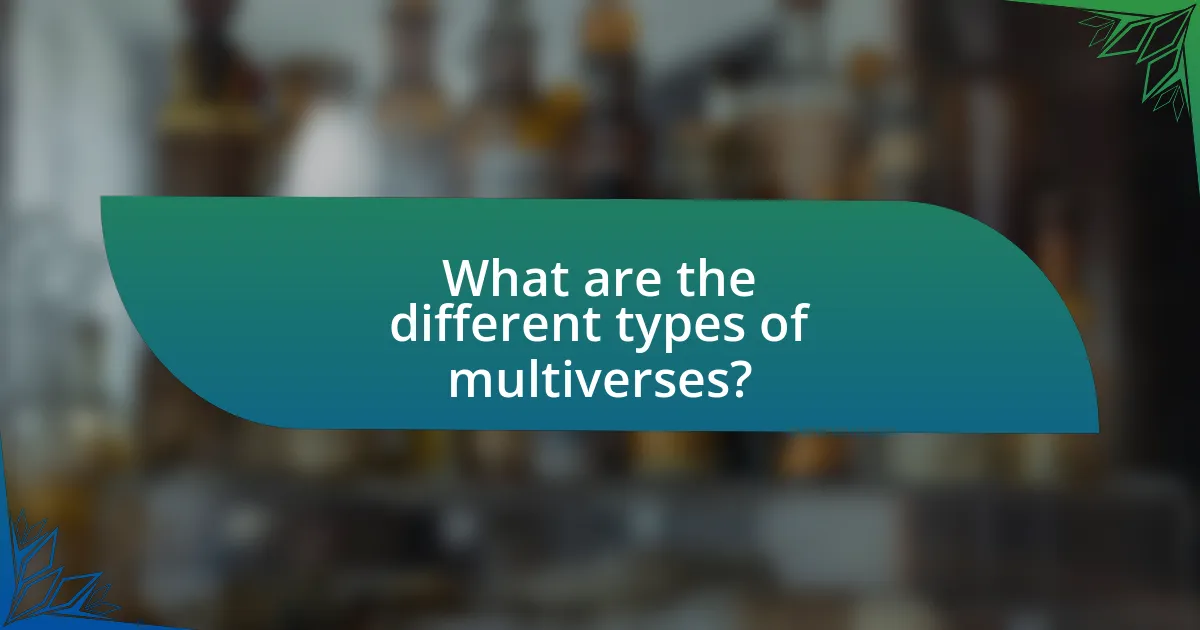
What are the different types of multiverses?
The different types of multiverses include the Level I multiverse, Level II multiverse, Level III multiverse, and Level IV multiverse. The Level I multiverse arises from the infinite nature of space, where regions beyond our observable universe have different configurations of matter. The Level II multiverse is based on the theory of cosmic inflation, suggesting that different regions of space can have varying physical constants and laws. The Level III multiverse is derived from the many-worlds interpretation of quantum mechanics, positing that all possible outcomes of quantum events occur in separate, branching universes. Lastly, the Level IV multiverse encompasses all mathematical structures, implying that any conceivable universe that can be described mathematically exists. These classifications are supported by theoretical frameworks in cosmology and quantum mechanics, providing a structured understanding of multiverse theories.
How do the types of multiverses differ from one another?
The types of multiverses differ primarily in their structure and the nature of their universes. The three main categories are: the Level I multiverse, which consists of infinite regions of space with varying configurations of matter; the Level II multiverse, which arises from different physical constants and laws in bubble universes formed during cosmic inflation; and the Level III multiverse, based on the many-worlds interpretation of quantum mechanics, where every quantum event spawns a branching universe. Each type reflects distinct theoretical frameworks and implications for the nature of reality, supported by concepts in cosmology and quantum theory.
What is the distinction between the many-worlds interpretation and other multiverse theories?
The distinction between the many-worlds interpretation and other multiverse theories lies in the nature of reality they propose. The many-worlds interpretation, originating from quantum mechanics, suggests that all possible outcomes of quantum events actually occur in separate, branching universes, thereby eliminating the concept of wave function collapse. In contrast, other multiverse theories, such as the cosmic inflation model, posit that multiple universes exist due to different initial conditions or physical constants, but do not necessarily imply that every possible outcome occurs. This fundamental difference highlights that while many-worlds focuses on the branching of realities from quantum events, other multiverse theories may involve entirely separate universes with distinct laws of physics or initial conditions.
How does cosmic inflation contribute to the multiverse theory?
Cosmic inflation contributes to the multiverse theory by suggesting that rapid expansion in the early universe can lead to the creation of multiple, distinct regions of space-time, each potentially evolving into separate universes. This theory posits that during inflation, quantum fluctuations can cause different parts of space to inflate at varying rates, resulting in diverse physical properties across these regions. Evidence supporting this comes from the cosmic microwave background radiation, which shows uniformity and slight variations consistent with inflationary models, indicating that different inflationary patches could give rise to different universes with unique characteristics.
What role does quantum mechanics play in multiverse theories?
Quantum mechanics plays a crucial role in multiverse theories by providing a framework for understanding the existence of multiple, parallel universes. Specifically, the Many-Worlds Interpretation of quantum mechanics posits that every quantum event results in a branching of the universe into different outcomes, leading to a vast number of coexisting realities. This interpretation is supported by the mathematical formalism of quantum mechanics, which allows for superposition and entanglement, suggesting that all possible outcomes of quantum measurements are realized in separate, non-communicating branches of the universe. Thus, quantum mechanics not only underpins the theoretical basis for multiverse concepts but also offers a scientific rationale for their existence through observable phenomena in quantum experiments.
How does quantum superposition relate to the existence of parallel universes?
Quantum superposition suggests that particles can exist in multiple states simultaneously until measured, which is a fundamental principle of quantum mechanics. This principle leads to the interpretation that every possible outcome of a quantum event occurs in its own distinct universe, thus supporting the concept of parallel universes. The Many-Worlds Interpretation, proposed by Hugh Everett III in 1957, posits that all possible outcomes of quantum measurements are realized in separate, branching universes, effectively creating a multiverse. This interpretation aligns with the mathematical framework of quantum mechanics, where the wave function encompasses all potential states, reinforcing the idea that superposition is intrinsically linked to the existence of parallel universes.
What experiments support the idea of multiverses in quantum physics?
Experiments that support the idea of multiverses in quantum physics include the double-slit experiment and the Many-Worlds Interpretation (MWI) of quantum mechanics. The double-slit experiment demonstrates that particles can exist in multiple states simultaneously, suggesting the possibility of parallel outcomes. In the context of MWI, when a quantum event occurs, the universe splits into different branches, each representing a different outcome. This interpretation aligns with the experimental observations of quantum superposition and entanglement, which indicate that particles can exist in multiple states until measured. Additionally, research by Hugh Everett III in 1957 formalized the Many-Worlds Interpretation, providing a theoretical framework that supports the multiverse concept.
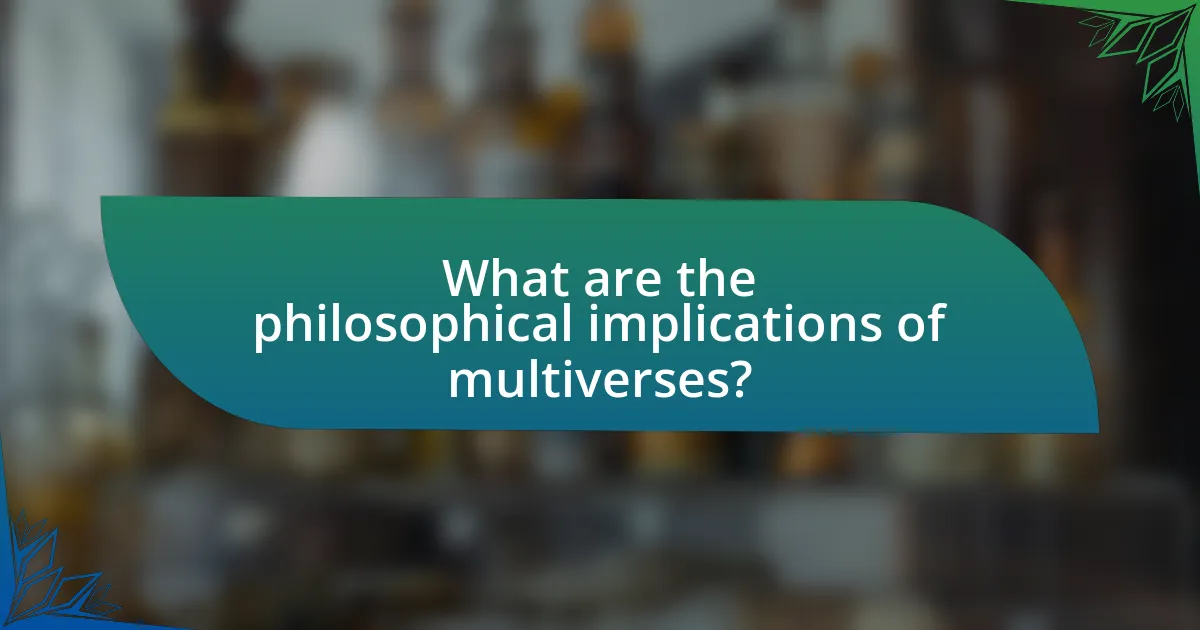
What are the philosophical implications of multiverses?
The philosophical implications of multiverses suggest that the existence of multiple universes challenges traditional notions of reality, identity, and causality. This concept raises questions about the nature of existence, as it implies that every possible outcome of every event could occur in some universe, leading to a re-evaluation of free will and determinism. Additionally, the multiverse theory complicates the understanding of uniqueness and significance, as individual experiences may be mirrored across countless realities. Philosophers like David Lewis have argued that such a framework could support modal realism, where all possible worlds are as real as the actual world, fundamentally altering our perception of truth and existence.
How do multiverses affect our understanding of free will?
Multiverses challenge traditional notions of free will by suggesting that every decision creates branching realities, leading to multiple outcomes. This concept implies that while individuals may feel they are making free choices, those choices exist within a framework where every possible outcome is realized in a separate universe. The many-worlds interpretation of quantum mechanics supports this idea, positing that all possible histories and futures are real, thus complicating the notion of singular free will. In this context, free will may be perceived as an illusion, as every choice is merely one of many paths taken across an infinite landscape of realities.
What arguments exist for and against the existence of free will in a multiverse?
Arguments for the existence of free will in a multiverse include the idea that multiple universes allow for different choices and outcomes, suggesting that individuals can exercise free will in selecting among various possibilities. This perspective aligns with the many-worlds interpretation of quantum mechanics, which posits that every decision creates branching realities, thereby supporting the notion of autonomy in decision-making.
Conversely, arguments against free will in a multiverse assert that if every possible choice leads to the creation of a new universe, then the concept of free will becomes illusory, as every action is predetermined by prior states of existence. This deterministic view implies that individuals are merely following a path dictated by the multiverse’s structure, undermining the authenticity of choice.
In summary, the debate hinges on whether the existence of multiple realities enhances or diminishes the concept of free will, with proponents emphasizing choice and opponents highlighting determinism.
How do multiverses influence concepts of identity and existence?
Multiverses influence concepts of identity and existence by suggesting that multiple versions of individuals exist across different realities, thereby challenging the notion of a singular self. This idea posits that each decision creates divergent paths, leading to alternate identities that reflect various choices and circumstances. For instance, in the many-worlds interpretation of quantum mechanics, every possible outcome of a decision occurs in a separate universe, implying that an individual’s identity is not fixed but rather a collection of experiences across these parallel realities. This perspective encourages a reevaluation of existence, as it implies that one’s life is just one of many potential narratives, thus expanding the understanding of what it means to be an individual.
What ethical considerations arise from the concept of multiverses?
The ethical considerations arising from the concept of multiverses include the implications of infinite realities on moral responsibility and the nature of existence. In a multiverse, every possible outcome occurs, which raises questions about accountability for actions, as individuals may exist in alternate realities where different choices are made. This challenges traditional notions of free will and moral judgment, as the existence of multiple versions of oneself complicates the understanding of right and wrong. Furthermore, the potential for alternate universes to contain vastly different ethical frameworks prompts discussions about the universality of moral principles. These considerations highlight the need for a reevaluation of ethics in light of the multiverse theory, as the implications extend to how we perceive life, choices, and consequences across potentially infinite realities.
How might multiverses impact moral philosophy?
Multiverses could significantly impact moral philosophy by introducing the concept of multiple realities where different moral outcomes exist. This plurality challenges the notion of a single moral truth, as actions could yield varying ethical consequences across different universes. For instance, a decision deemed morally right in one universe might lead to negative outcomes in another, prompting philosophers to reconsider the foundations of ethical theories such as utilitarianism or deontology. The existence of multiverses suggests that moral relativism may gain traction, as individuals could argue that moral judgments are context-dependent, varying across different realities. This perspective aligns with the idea that moral frameworks must adapt to account for the complexities introduced by the multiverse theory, as articulated by philosophers like David Lewis, who explored modal realism, suggesting that all possible worlds are as real as the actual world.
What are the potential consequences of believing in multiple realities?
Believing in multiple realities can lead to significant psychological and philosophical consequences. Individuals may experience a shift in their perception of existence, leading to existential uncertainty and questioning of their own reality. This belief can foster a sense of liberation, as it allows for the acceptance of diverse perspectives and experiences, but it may also result in confusion and difficulty in making decisions grounded in a singular reality. Furthermore, such beliefs can impact social interactions, as individuals may struggle to communicate effectively with those who do not share the same worldview, potentially leading to isolation or conflict.
What are the practical implications of multiverse theories?
Multiverse theories suggest that multiple, perhaps infinite, universes exist alongside our own, which has several practical implications. One significant implication is the potential for advancements in understanding fundamental physics, as these theories challenge and expand upon the current models of cosmology and quantum mechanics. For instance, the Many-Worlds Interpretation of quantum mechanics posits that every quantum event branches into different outcomes, which could lead to new insights in fields like quantum computing and information theory. Additionally, multiverse theories may influence philosophical discussions about the nature of reality and existence, prompting reevaluation of concepts such as free will and determinism. Furthermore, if multiverses exist, it could impact the search for extraterrestrial life, as different universes may harbor varying physical laws and conditions conducive to life.
How can understanding multiverses influence scientific research?
Understanding multiverses can significantly influence scientific research by expanding theoretical frameworks and guiding experimental approaches. The concept of multiverses suggests the existence of multiple, perhaps infinite, universes with varying physical laws and constants, which can lead researchers to explore new hypotheses about the nature of reality. For instance, theories such as string theory and quantum mechanics have been influenced by multiverse ideas, prompting investigations into phenomena that may not be observable in our universe but could exist in others. This exploration can lead to advancements in fields like cosmology, particle physics, and even philosophy of science, as researchers seek to understand the implications of these alternate realities on fundamental questions about existence and the universe’s origins.
What are the potential applications of multiverse theories in technology?
Multiverse theories have potential applications in technology, particularly in quantum computing and simulation technologies. Quantum computing leverages principles from multiverse theories, such as superposition and entanglement, to perform complex calculations at unprecedented speeds. For instance, researchers at IBM have explored how quantum bits can exist in multiple states simultaneously, akin to the multiverse concept, which could revolutionize data processing and cryptography. Additionally, multiverse theories can inform advanced simulations in fields like virtual reality and artificial intelligence, allowing for the creation of more realistic and adaptive environments by modeling various outcomes and scenarios. These applications demonstrate the intersection of theoretical physics and practical technology, showcasing how abstract concepts can lead to tangible advancements.
How can one explore the concept of multiverses further?
One can explore the concept of multiverses further by engaging with theoretical physics literature, particularly works that discuss string theory and quantum mechanics. For instance, the Many-Worlds Interpretation of quantum mechanics, proposed by Hugh Everett III in 1957, suggests that all possible outcomes of quantum measurements are realized in separate, branching universes. Additionally, reading books such as “The Hidden Reality” by Brian Greene provides insights into various multiverse theories, including cosmic inflation and the landscape multiverse. Engaging with academic journals like “Physical Review D” can also offer peer-reviewed articles that delve into the mathematical frameworks supporting multiverse theories.
What resources are available for learning about multiverses?
Books, online courses, and academic papers are key resources for learning about multiverses. Notable books include “The Hidden Reality” by Brian Greene, which explores various multiverse theories, and “Parallel Universes” by Fred Alan Wolf, which discusses the implications of quantum mechanics on the multiverse concept. Online platforms like Coursera and edX offer courses on cosmology and theoretical physics that cover multiverse topics. Additionally, academic papers such as “Eternal Inflation and its Implications” by Andrei Linde provide in-depth analysis and research findings related to multiverses. These resources collectively offer a comprehensive understanding of the multiverse concept.
How can engaging with multiverse theories enhance critical thinking skills?
Engaging with multiverse theories enhances critical thinking skills by encouraging individuals to analyze complex concepts and evaluate multiple perspectives. This engagement requires the application of logical reasoning to assess the implications of various multiverse models, such as the many-worlds interpretation of quantum mechanics, which posits that every possible outcome of a quantum event occurs in its own separate universe. By grappling with these intricate ideas, individuals develop the ability to question assumptions, identify biases, and construct coherent arguments, thereby strengthening their overall analytical capabilities.
